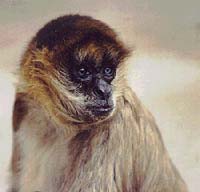 |
 |
| Name: Spider Monkey |
| Scientific name:Ateles geoffroyi |
| Range: Mexico, Central America, South America |
| Habitat: lowland and mountainous rain forests (areas with high concentration of fruits and trees). |
| Status: Endangered |
| Diet in the wild: fruits |
| Diet in the zoo: fruits |
| Location in the zoo: not currently on exhibit |
| Physical
description:
Bodies are approximately 20in. long and the prehensile tail makes them a total of aroung 5 ft. long. They weigh approximately 13 to 25 lbs. Spider monkeys come in golden, red, buff, gray,brown, and black. General
information:
|
|
| Special
anatomical, physiological or behavioral adaptations:
The spider monkey lacks a thumb, so they are not very good manipulators. They have a prehensile tail that makes up for the lack of a thumb because it can be used like a hand to carry objects with . The tail has a fleshy pad on its underside which allows them to hang securely with hands free.The tail is strong enough to grip a limb and support its entire body weight. |
|
| Comments
about the spider monkeys of the Fort Worth Zoo:
The spider monkeys at the Fort Worth Zoo all came from Alabama except for one, which came from South Dakota. The male has been sterilized so that no more breeding will take place. Three births have taken place among them since they got there. The oldest spider monkey at the Fort Worth Zoo is recorded to have been born in 1966. |
|
| Personal
Observations:
When humans come into area around them, they become very excited. They throw fruit or anything available and run around very energetically. They make threatening noises and gestures. The spider monkeys also act very humanlike in some ways. The games that they play together look like games that human children play. They also seem to be worried about their appearance somewhat the way humans do. They are always putting their hair back into place and picking bugs off each other. |
|
| Current
research:
To see more information on spider
monkeys visit the Birmingham Zoo site at
|
|
| Page
author: Devon Montgomery
email: dev88@hotmail.com |
|
|
|
| Source
of information:
http://www.sazoo-aq.org/spidmonk.html www.birminghamzoo.com/ao/mammal/ghspider.htm
|